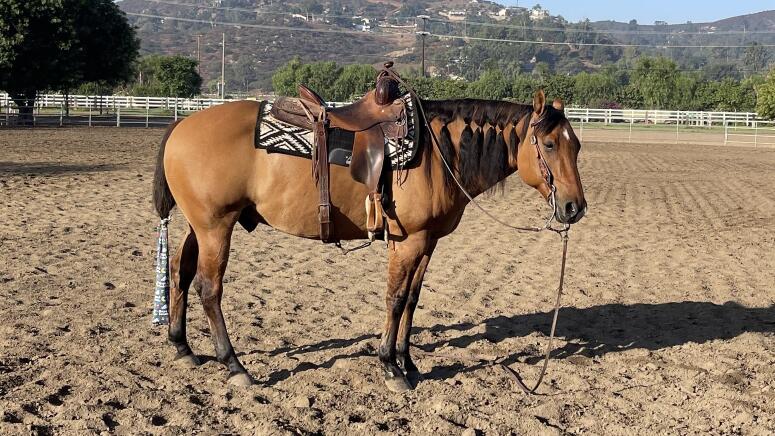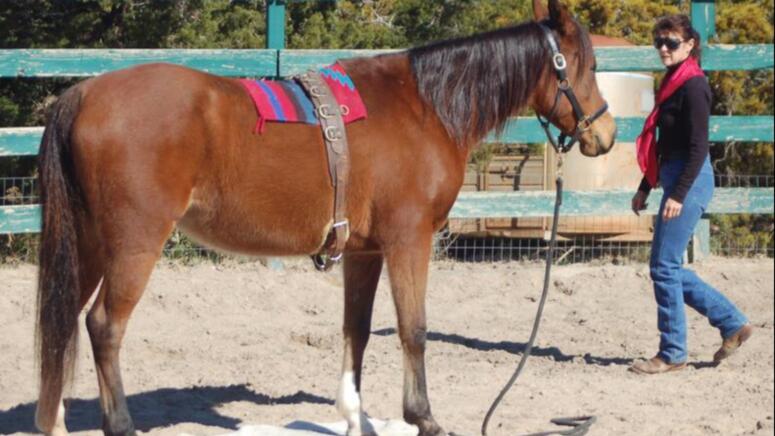Posted by Suzanne De Laurentis, Thu, Jun 30, 2016
Ground tying demonstrates a high level of obedience and self-control on the part of the horse. It is a skill that can be extremely useful for a working horseman, when trail riding or simply as a mental exercise for a horse!
Before teaching your horse to ground tie, they should be able to stand quietly when tied. Horses that stand quietly are usually welcome anywhere and will make your life a lot easier.
Most horses that have difficulty with standing while tied have not been trained to do so. Because a horse is halter trained does not necessarily mean that they are trained to tie. Some horses are claustrophobic or fearful when tied, which is usually the result of a bad experience. If you think your horse may have had a bad experience when tied, seek professional advice.
Tying Tips
Always tie a horse higher than their withers. If tied lower than wither height and they pull back, the angle will put them at risk for spinal damage or even a broken neck. Don’t give a horse a lot of rope when tied; we like to give a tied horse only about 2? feet of rope. If possible, tie to an overhead tree branch that will give slightly if the horse pulls. If tying to a post or other non-flexible station, tie to a ring on a stretchy tire inner tube or use one of the “easy” tie pieces of hardware available (such as the Blocker Tie) that makes the process of tying easy and safe. We do not use the elastic ties with snaps on the ends because they sometimes break if a horse pulls back and propels the snap through the air at high speed.
Increase tie time slowly, especially if a horse is fearful. It is safest to use a nylon web or leather halter rather than a rope halter and a padded top strap is also ideal. Be sure that a tied horse is close enough for them to easily be reached if they need to have the rope cut in an emergency.
Don’t tie a foal or young horse in a hard and fast manner, as it could result in permanent damage to their spine or even death. A foal’s bones and spinal structure are not solid for several years, and if one pulls back when tied hard they may pull the spinal column apart or tear the ligaments.
Most horses will stand quietly once they learn that any amount of wriggling or pulling will not result in freedom.
If a tied horse pulls back, do not panic, even if they cause a ruckus. Yelling at them will only scare them and rushing in to try to help them may result in your own injury. Stay calm and assess the situation before you act.
Teach the Ground Tie
We use several methods to teach the ground tie and vary the methods to suit the learning style and ability of each individual horse. Ground tying is a skill that takes time and patience to teach.
Method 1: Pedestal and Target Method
All of our horses are pedestal trained, which makes ground tying an easy transition. We lunge the horse on a working length line, guide them toward the pedestal and ask them to “Step Up” with their front feet. When they are on the pedestal, drop the lead line and give them the verbal cue of either “Stay” or “Stand.” At first, stand close to them so they don’t get the idea to step down before you give them a release cue (we use “Step Back”). When they have stood for a few seconds, praise them and cue them to step back and down from the pedestal. The amount of time for which they are asked to stand should be increased by just a second or two with each repetition. If they step down before you give the release cue, just send them to work in the pen for a few minutes and then ask them again to “Step Up.” This makes it easy for most horses to understand the instructions and intention that they stand. The amount of time for which they remain ground tied can be increased as their reliability increases. We step just a few feet farther away from them with each repetition of the exercise. We don’t talk to the horse while they are ground tied as we don’t want them to interpret chatter as an invitation to move.
As the horse becomes conditioned and obedient to the “Stay” and/or “Stand” request while on the pedestal, we often exchange it for a rubber mat or piece of carpet to use as a target or mark. This makes it very easy for the horse to understand the transition from the pedestal to the ground. Over time the mark can be removed, and the horse can be asked to stay where they are cued within the pen or corral.

Horses learn quickly when they are “routined,” which means that they are (initially) asked for the desired behavior in exactly the same location each and every time. Make absolutely no variations in your teaching procedure and pay attention to the details.
When the horse is dependable at the ground tie in the corral or round pen, we move to the arena where there is no green grass to tempt them. We don’t make immediate changes in their routine and we test and re-test their obedience in as many different situations as possible before the time comes when we may need them to Ground Tie.
Method 2: Without a Target
The ground tie can also be taught without a pedestal or mark by simply dropping the horse’s lead line, giving them a verbal cue (“Stand” or “Stay”), and standing next to them. Take a step or two back and repeat the verbal command. If they make a movement to walk away or come toward you, tell them “No” and put them back where they were. Most horses will easily understand this exercise with a few repetitions. If they persist in walking after they have been cued to stand, give them a slight bump on the nose with the lead as you tell them “No” and put them back into position. Incrementally increase the amount of distance between you and the horse as you step away from them as well as (gradually) the amount of time for which they are asked to stay. If the horse continues to wriggle or walk off, put them to work at a brisk pace in the round pen for a few laps and repeat the standing still process. This is to be done with no negative emotion from the handler and is not to be in any way construed as punishment! It is simply a way to help them “desire” to stay where you ask rather than work. They will come to see staying still as a reward, especially if they are praised in a way that they understand such as stroking or even a horse treat.
When they stand quietly at regular intervals with the lead rope dropped, walk up to them and praise them with strokes on the neck so they understand that they are pleasing you by standing still.
Gradually increase the distance you leave between yourself and the horse when they are ground tied.

Method 3: The Rope Method
This method can be used by itself or to perfect or reinforce the ground tie. This can be done with either a saddle or surcingle that has rings in the belly band or cinch. If you use a saddle, be sure that the horse is in an enclosed area so that they don’t venture away with it.
Use a very small diameter line about 50 feet long. A dark color such as black, dark blue or dark gray seems to work best, as they are not as obvious to the horse. For demonstration purposes we used a red rope. A small snap at one end or a simple slip knot will attach the line to the halter; do not attach it to a bit as this could result in injury to the horse’s mouth. Either a knotted nose halter or a wide nose band halter will work, depending on the sensitivity of the individual horse.
Attach the small diameter line to the halter ring and run it through the ring on the cinch or belly band. Do NOT put it under the cinch! Have a regular lead line attached to the halter ring as well.
Place the horse where you want them to ground tie. Drop the lead line and ask the horse to “Stay” or “Stand” on their regular training spot. Hold the rope coils of the small diameter rope in your hand and quietly drop the line as you begin to walk or back away from them. Do not draw attention to the small tie rope. We keep the rope to the side of the horse or at a 90° angle. If they are obedient and stay, that’s great! If they move, give them a little tug with the line. They may seem surprised to feel the tug if you are some distance away from them! As with the previous ground tie training methods, increase the amount of time for which the horse is asked to “Stay” incrementally and help them to be successful.
As in the training of any move or trick, there must be something in it for the horse. It can be praise, a horse treat, a few minutes of grazing or even getting off work early for the day.
Other Considerations
Be reasonable! This skill takes patience to teach. Once you leave the environs of the round pen and begin practicing the ground tie in the open, you will need to carefully consider the location you choose in the beginning. For example, do not expect a horse to remain ground tied with grass nearby or other horses running around them.
Author Profile: Suzanne De Laurentis
Alan Pogue and Suzanne De Laurentis, authors of the book "The Trick Horse Companion" and owners of Imagine a Horse, have spent a quarter of a century perfecting modern trick training methods.
Enlightened Trick Training is intended to increase the intelligence, adaptability and predictability of today's companion horse as well as enhance the relationship between horse and rider.
More Blogs by Suzanne de Laurentis
- https://www.mannapro.com/equine/horse-training-tips-teach-your-horse-to-ground-tie
- https://www.mannapro.com/equine/imagine-a-mini-miniature-horse-training-basics
Featured Products

